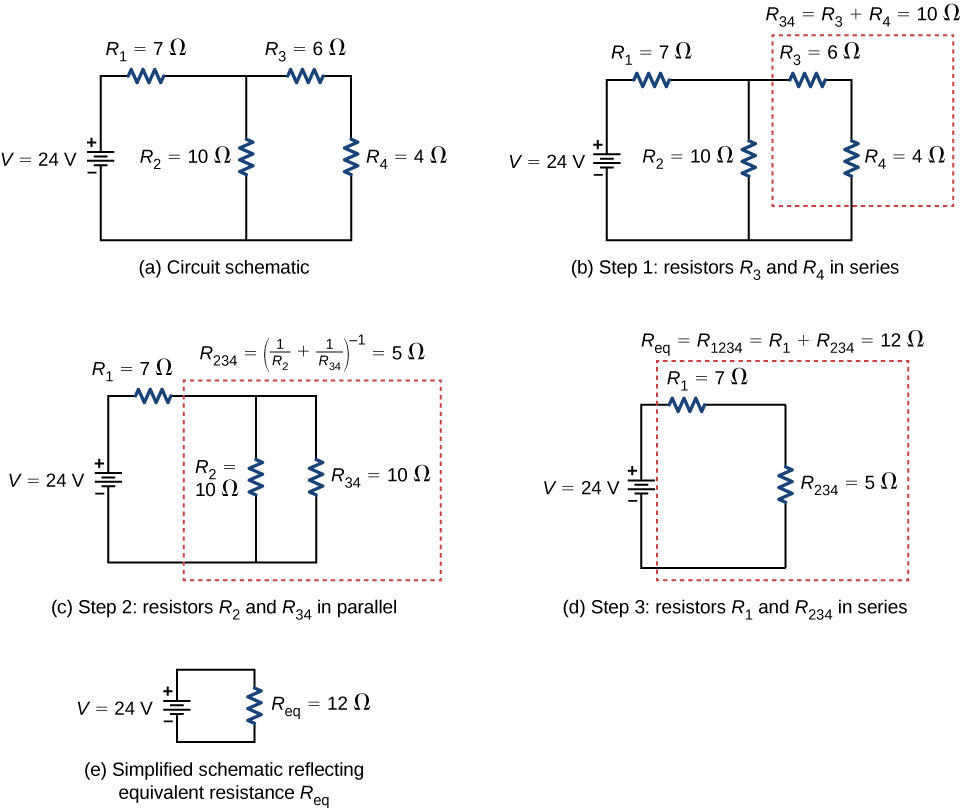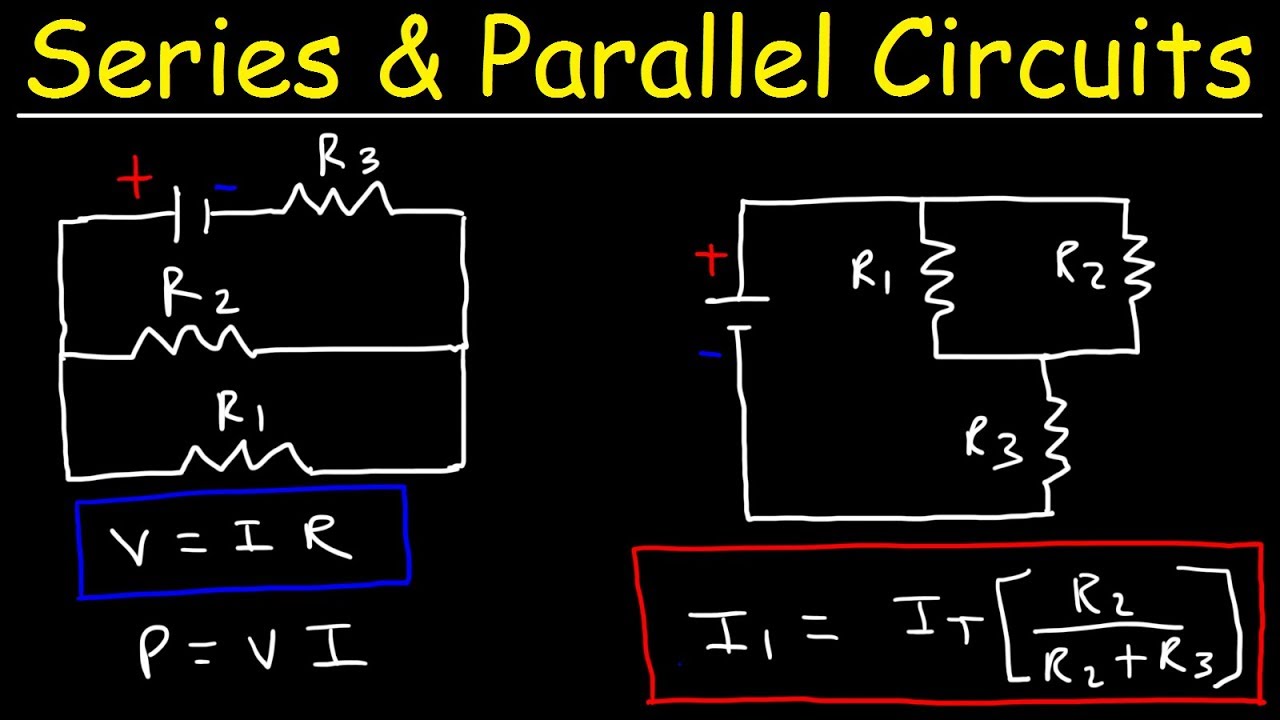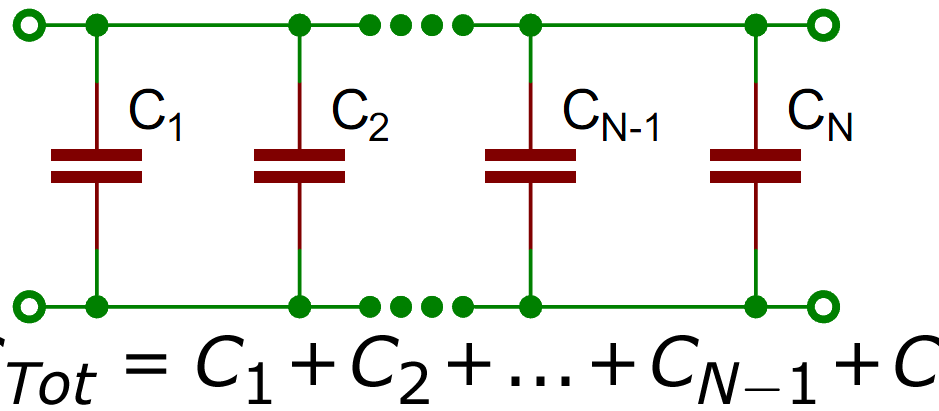To calculate the total resistance in a series circuit, simply add up the resistance values of all resistors. The formula is R_total = R1 + R2 + R3 + … + Rn.
Resistors in series are a fundamental concept in electronics. They are connected end-to-end, forming a single path for current flow. This arrangement results in a cumulative resistance that affects the entire circuit. Series circuits are widely used in various applications, from household wiring to complex electronic devices.
Understanding how to calculate the total resistance is crucial for designing and troubleshooting these circuits. This knowledge helps ensure that circuits function correctly and safely. Whether you’re an engineer, student, or hobbyist, mastering series resistor calculations is essential for effective circuit design and analysis.
Introduction To Series Resistors
Resistors are crucial in electronic circuits. They control the flow of current. Resistors in series add up to increase resistance. This helps manage electrical loads.
Importance In Circuits
Series resistors play a significant role. They ensure devices operate safely. Series resistors can protect components from excessive current. This is vital for circuit stability.
Basic Principles
Understanding series resistors is simple. The total resistance is the sum of all resistors in the series.
Formula: Rtotal = R1 + R2 + R3 + … + Rn
Each resistor adds its resistance to the total. This makes calculation straightforward.
| Resistor | Value (Ohms) |
|---|---|
| R1 | 10 |
| R2 | 20 |
| R3 | 30 |
Total resistance: 10 + 20 + 30 = 60 Ohms
Here are some key points:
- Resistors in series add together.
- Total resistance increases.
- Current flow is controlled.
To sum up, series resistors are easy to understand. They are important in many circuits.
Ohm’s Law Essentials
Ohm’s Law is the foundation of electrical circuits. It explains the relationship between voltage, current, and resistance. This law is crucial for calculating resistors in series. Understanding these basics will help you solve electrical problems.
Voltage
Voltage is the force that pushes electric current through a circuit. It is measured in volts (V). In a series circuit, the total voltage is the sum of individual voltages across each resistor.
Formula: \( V_{total} = V_1 + V_2 + V_3 + … + V_n \)
Current
Current is the flow of electric charge. It is measured in amperes (A). In a series circuit, the current remains the same through each resistor.
Formula: \( I_{total} = I_1 = I_2 = I_3 = … = I_n \)
Resistance
Resistance is the opposition to the flow of current. It is measured in ohms (Ω). In a series circuit, the total resistance is the sum of individual resistances.
Formula: \( R_{total} = R_1 + R_2 + R_3 + … + R_n \)
Mathematical Formula
To calculate the total resistance in a series circuit, use the formula:
R_total = R_1 + R_2 + R_3 + ... + R_n
This formula helps you find the total resistance easily. Just add all the resistances together.
For example:
| Resistor | Value (Ω) |
|---|---|
| R1 | 10 |
| R2 | 20 |
| R3 | 30 |
Total Resistance: \( R_{total} = 10 + 20 + 30 = 60 \) Ω
Understanding these basics will make resistor calculations in series circuits straightforward.
Calculating Total Resistance
Understanding how to calculate the total resistance in a series circuit is crucial. This knowledge helps in designing and troubleshooting electrical circuits effectively. In a series circuit, resistors are connected end-to-end, and the total resistance is the sum of individual resistances.
Adding Resistors In Series
In a series circuit, the resistors are connected one after another. This means the current flows through each resistor sequentially. The total resistance (Rtotal) is the sum of all individual resistances. The formula is simple:
Rtotal = R1 + R2 + R3 + ... + RnEach resistor adds to the total resistance. This is because the current has only one path to follow.
Example Calculations
Let’s look at some example calculations to understand this better. Suppose you have three resistors in series with the following resistances:
- R1 = 10Ω
- R2 = 20Ω
- R3 = 30Ω
To find the total resistance, use the formula:
Rtotal = R1 + R2 + R3Substitute the values:
Rtotal = 10Ω + 20Ω + 30ΩSo, the total resistance is:
Rtotal = 60ΩHere is another example with four resistors:
- R1 = 5Ω
- R2 = 15Ω
- R3 = 25Ω
- R4 = 35Ω
Calculate the total resistance:
Rtotal = R1 + R2 + R3 + R4Substitute the values:
Rtotal = 5Ω + 15Ω + 25Ω + 35ΩThe total resistance is:
Rtotal = 80ΩThese examples show how easy it is to calculate total resistance in series. Just add the resistances together.

Credit: phys.libretexts.org
Practical Applications
Understanding resistor calculation in series has many real-world uses. It helps in designing efficient and functional electronic circuits. Below are some practical applications and tips.
Common Uses
Resistors in series are often used to control current and voltage. They can be found in various electronic devices like:
- LED circuits
- Power supplies
- Voltage dividers
Using resistors in series also helps in protecting components from high voltage. This is crucial in ensuring the longevity of electronic devices.
Circuit Design Tips
Here are some tips for designing circuits with resistors in series:
- Calculate Total Resistance: Add up all resistor values. For example, if you have three resistors of 10Ω, 20Ω, and 30Ω, the total resistance is 60Ω.
- Verify Power Ratings: Ensure each resistor can handle the power it will dissipate. Use the formula
P = V²/Rto find the power rating. - Use Tolerance Values: Consider the tolerance of resistors to ensure accuracy. For example, a 10Ω resistor with 5% tolerance can be between 9.5Ω and 10.5Ω.
Below is a table showing the total resistance calculations for different resistor combinations:
| Resistor 1 (Ω) | Resistor 2 (Ω) | Resistor 3 (Ω) | Total Resistance (Ω) |
|---|---|---|---|
| 10 | 20 | 30 | 60 |
| 5 | 15 | 25 | 45 |
| 2 | 3 | 4 | 9 |
Applying these tips ensures your circuit is both efficient and reliable. Remember, accurate calculations are key to successful circuit design.
Tools And Techniques
Resistor calculation in series can be simple with the right tools. Using these tools can help you get accurate results. Here, we will look at two main methods: multimeters and simulation software.
Using Multimeters
A multimeter is a handy device for measuring electrical values. It can measure resistance, voltage, and current. To calculate resistors in series, follow these steps:
- Set the multimeter to the resistance mode (ohms).
- Connect the multimeter leads to the series resistors.
- Read the value displayed on the multimeter.
The total resistance of resistors in series is the sum of individual resistances. For example:
| Resistor 1 | Resistor 2 | Resistor 3 | Total Resistance |
|---|---|---|---|
| 100Ω | 200Ω | 300Ω | 600Ω |
Using a multimeter ensures you get the exact resistance value. This is important for circuit design and troubleshooting.
Simulation Software
Simulation software offers a virtual way to calculate resistors in series. These tools can simulate complex circuits without physical components. Popular software includes LTSpice and Proteus.
To use simulation software:
- Open the simulation software.
- Draw the circuit with series resistors.
- Run the simulation to see the total resistance.
Simulation software is great for testing and learning. It allows you to see how circuits work without building them. This saves time and resources.
Both multimeters and simulation software are valuable for resistor calculation. Choose the tool that best fits your needs.
Troubleshooting Common Issues
Understanding how to calculate resistors in series is crucial. Mistakes can lead to incorrect circuit behavior. This section covers troubleshooting common issues. You’ll learn to identify faulty resistors and ensure accurate measurements.
Identifying Faulty Resistors
Faulty resistors can disrupt your circuit. Signs of faulty resistors include visible damage, such as burns or discoloration. Use a multimeter to check resistance values. Compare these values with the resistor’s rated value.
- Turn off the power before testing.
- Set your multimeter to the correct range.
- Touch the probes to the resistor’s terminals.
- Read the resistance value on the multimeter.
If the value is far from the rated value, the resistor might be faulty. Replace it with a new one of the same specification.
Ensuring Accurate Measurements
Accurate measurements are vital for reliable resistor calculation. Using a calibrated multimeter is essential. Always check your tools before use.
- Ensure the multimeter is in good condition.
- Calibrate the multimeter if necessary.
- Set the appropriate measurement range.
- Double-check connections before taking readings.
Avoid measuring resistors in a live circuit. This can lead to inaccurate readings and potential damage. Disconnect the resistor from the circuit first.
Keep in mind environmental factors. Temperature and humidity can affect resistor values. Conduct measurements in a controlled environment.
| Common Issues | Solutions |
|---|---|
| Incorrect readings | Check multimeter calibration |
| Visible resistor damage | Replace the resistor |
| Unstable values | Measure in a controlled environment |
Advanced Considerations
Calculating resistors in series can be simple. But, advanced considerations are crucial for precise work. Let’s explore how temperature and tolerance affect resistor calculations.
Temperature Effects
Temperature changes can impact resistor values significantly. Resistors can heat up during operation. This heating can change their resistance.
Each resistor has a Temperature Coefficient. This coefficient shows how much a resistor’s value changes with temperature. Measured in ppm/°C (parts per million per degree Celsius).
For example, if a resistor has a temperature coefficient of 100 ppm/°C:
R_temperature = R_nominal (1 + (Temperature Coefficient ΔTemperature))
Let’s say the nominal resistance is 1000 ohms. If the temperature rises by 10°C:
R_temperature = 1000 (1 + (100 10^-6 10)) = 1001 ohms
This calculation shows a 1 ohm increase, which might be crucial in precise circuits.
Tolerance Levels
Resistors come with different tolerance levels. Tolerance indicates how much the resistor value can vary from its nominal value. Common tolerances are 1%, 5%, and 10%.
For a 1000 ohm resistor with 5% tolerance:
Minimum Resistance = 1000 (1 - 0.05) = 950 ohms Maximum Resistance = 1000 (1 + 0.05) = 1050 ohms
This range ensures the resistor operates correctly within the specified limits. Combining resistors in series, their total tolerance must be considered.
- Sum the nominal resistances.
- Consider the worst-case tolerance scenario.
For example, three resistors of 1000 ohms each with 5% tolerance in series:
Total Resistance = 1000 + 1000 + 1000 = 3000 ohms Tolerance Range = 3000 0.05 = 150 ohms
So, the total resistance can range from 2850 to 3150 ohms.
Understanding these factors ensures accurate resistor calculations. Temperature and tolerance are key in advanced electronic designs.

Credit: www.electronics-tutorials.ws
Summary And Best Practices
Understanding how to calculate resistors in series is crucial for anyone working with electrical circuits. This section provides a concise summary and best practices to help you master this essential skill. By following these guidelines, you can ensure accurate calculations and efficient circuit design.
Key Takeaways
- Total Resistance: In a series circuit, add all resistor values to find the total resistance.
- Current Flow: The current remains the same through all resistors in series.
- Voltage Drop: Each resistor causes a voltage drop, proportional to its resistance.
Best Practices
- Use Consistent Units: Ensure all resistor values are in the same unit before adding.
- Double-Check Calculations: Verify your math to avoid errors in the circuit.
- Label Resistors Clearly: Mark each resistor with its value to simplify troubleshooting.
- Understand Circuit Behavior: Know how changes in resistance affect current and voltage.
Further Reading
To deepen your understanding of resistor calculations and circuit design, explore these resources:
- Electronics Tutorials on Resistors
- Khan Academy: Resistance in Series and Parallel
- All About Circuits: Series and Parallel Resistor Networks
Frequently Asked Questions
What Is A Series Resistor Calculation?
A series resistor calculation involves adding the resistance values of all resistors connected in a single path. The total resistance is the sum of individual resistances.
How Do You Calculate Total Resistance?
To calculate total resistance in a series circuit, simply add the resistance values of each resistor. The formula is \(R_{total} = R_1 + R_2 + R_3 + \ldots + R_n\).
Why Are Resistors Used In Series?
Resistors are used in series to increase the overall resistance. This helps control the current flow in the circuit.
What Happens If One Resistor Fails In Series?
If one resistor fails in a series circuit, the entire circuit stops working. This is because the current path is broken.
Conclusion
Understanding resistor calculation in series is crucial for circuit design. It ensures accurate voltage and current distribution. By mastering this, you can enhance your electronics projects. Keep practicing these calculations to improve your skills. Remember, precision in resistor calculation leads to efficient and reliable circuits.
Happy experimenting!








3 thoughts on “Resistor Calculation in Series: Master the Basics Effortlessly”